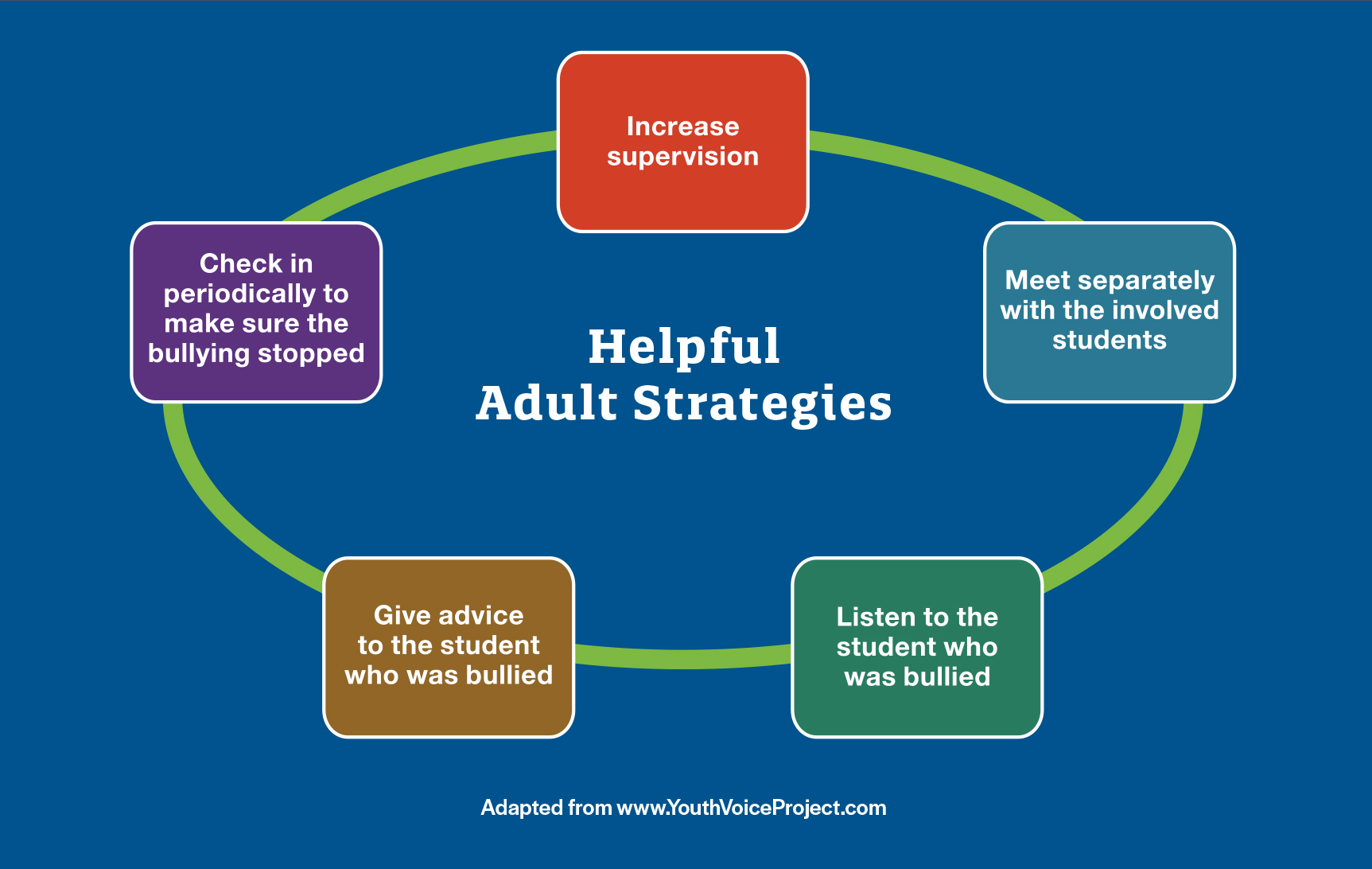
All adults, whether at home, at school or in the community, have a significant role to play in bullying prevention and intervention. Adults should refrain from labeling children as “tattletales” and listen when a child reports bullying concerns. By being effective and empathetic listeners, adults are positioned to assist children who are impacted by bullying.
Parents can increase the likelihood that their child will report bullying experiences by making listening to a part of the daily routine. During dinner or another part of the day, initiate regular “talk sessions” and express interest in your child’s day and allow the child to take the lead in talking about what is on their mind.
If a child shares a story of bullying, listen patiently and without judgment. Adults should always start a conversation with “I’m sorry this happened, and this is not your fault. No one deserves to be mistreated.” Ask questions in conversation – not interrogation – help the child brainstorm possible responses and ask the child what help they need.
Adults should serve as positive role models. Take care to ensure that your interactions with others are not abusive or harassing. Children learn from watching adults. It is important that your actions communicate that bullying behavior is unacceptable.
All adults should:
- Recognize the signs and symptoms of a child who may have been bullied.
- Intervene when bullying is suspected.
- Talk with students about what bullying is and is not.
- Reinforce appropriate bystander behavior.
- Communicate with supervising adults in a timely manner.
Sample questions to ask:
- What happened?
- What happened right before this incident?
- Who was there?
- Where did this happen?
- What time of day, during what period at school, before or after practice?
- Was there an adult present?
- Did anyone report this to an adult?
- Is there an adult at school that you would feel comfortable going to?
The Role of Educators
Educators have an important role in addressing acts of bullying they observe or that are reported to them. By being vigilant in addressing instances of peer aggression, educators can effectively reduce the likelihood of bullying in their schools using these strategies:
Understand the difference between bullying and conflict.
Conflict involves antagonism among two or more people. Any two people can have a conflict. Bullying only occurs when there is a power imbalance.
Understand that there are different ways to bully.
Bullying behaviors take several forms, including direct bullying, cyberbullying and relational aggression.
Understand that there are possible legal concerns for your school when bullying issues are not addressed.
This includes state laws related to bullying and bullying prevention, state and federal civil rights laws, and civil suits brought against schools and school systems.
Intervene every time you see bullying or it is reported to you.
It is important that you address all instances of peer aggression and take all reports of bullying seriously. Follow your school’s protocol for investigation and response.
Communicate with administrators.
Whenever you take action in bullying situations, be sure to document your actions and follow the school policies regarding reporting to other staff and parents. Effective management of bullying requires open communication to prevent reoccurrence. Administrators should ensure there is ongoing communication among supervising staff when bullying is reported, suspected or confirmed.
Follow up with students who have experienced bullying.
These follow-up conversations allow you to determine whether the behavior has stopped or if it is recurring. Provide support to students through increased supervision, proactive intervention and advocacy, if needed.
Avoid Common Pitfalls of Bullying Prevention
- Do not assume there is a “profile” of the student who most likely will bully, be a target, or be a bystander.
- Do not handle bullying incidents by having the two involved students “sit down and talk it out.”
- Do not believe that bullying occurs only when adults are not present.
- Do not think that bullying prevention is someone else’s job.
- Do not disregard your school’s bullying policies and procedures because they are a hassle, or you are unclear about what to do.
The Role of Healthcare Providers
Bullying has many health implications, including mental health issues, psychosomatic complaints of stomach pain, headaches, sleep problems, and general school avoidance behaviors. In addition, students who are bullied may experience short-term or long-term symptoms of depression or anxiety.
Healthcare providers should be aware of the American Academy of Pediatrics policy statement on the Role of Pediatricians in Youth Violence Prevention.
Healthcare providers should:

Active supervision is a key to preventing and addressing bullying.
If you see bullying or sense that it may be occurring, speak up and take steps to ensure that the environment is safe. Let children know what behavior is expected and what behavior is unacceptable. Offer structured activities that include all students. Intervene in all instances of observed peer aggression. Take time to follow up with involved students. Children often report bullying during private conversations with adults who care.
